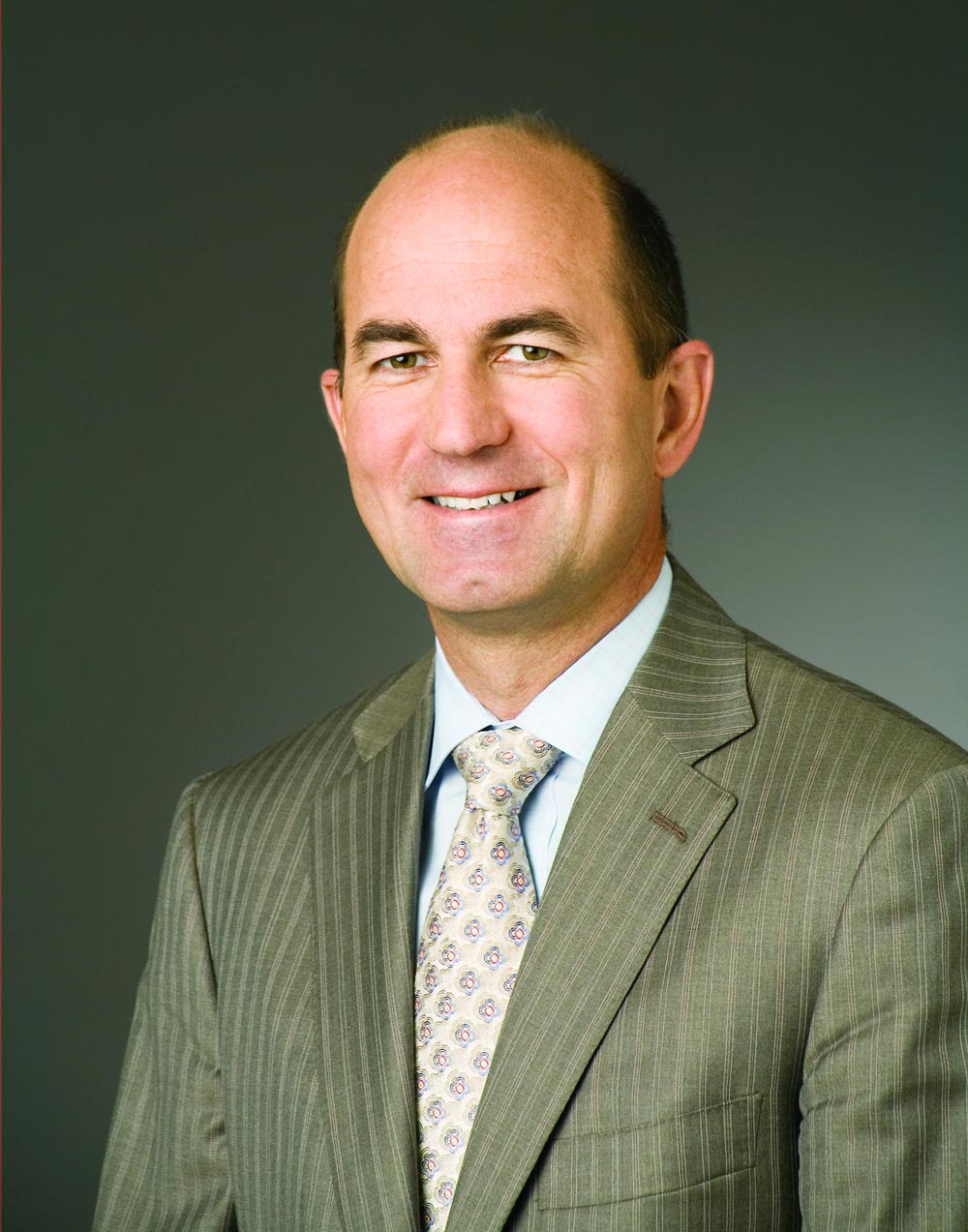
Under the new Rockwell Collins organization, Dr. David Vos is a senior director. He holds patents in nonlinear control systems, failure detection systems, optimal power control systems and more.
By Henry M. Holden
On March 3, Athena Technologies Inc., headquartered in Warrenton, Va., announced its acquisition by Rockwell Collins Inc. for an undisclosed sum. Dr. David Vos, founder and CEO of Athena, is a pioneer in the field of unmanned aerial vehicle solutions. Vos said the brand equity, which is Athena and GuideStar, will remain, along with all of its personnel. Athena primarily has provided UAV technology for military applications.
“We’ll build on it under the Rockwell Collins name,” he said. “I expect the company to continue to grow and pioneer the convergence of manned and unmanned airspace.”
Vos, who founded Athena in 1998, said the relationship with Rockwell provides an exciting and enabling platform to leverage the company’s successful navigation and controls systems, which will play a leading role in the future use of manned and unmanned aviation.

The inset photo shows an aileron separation on a sub-scale F/A-18 UAV. Software, acting faster than human response, will determine the best method to recover controlled flight.
“The strategic path we’ve been on has resulted in this acquisition,” Vos said. “When you look at the big picture, where we have common solutions to manned and unmanned aviation and where they can be collocated in the same airspace, you quickly realize it has to be a collaborative effort on many fronts.”
Athena started building collaborative relationships a few years ago.
“As discussions evolved and Athena’s presence began to mature, most of the companies we were talking with about collaboration began to view us from the point of view of acquisition, or a joint venture,” he said.
Under the new organization, Vos is a senior director in charge of moving the current business plan forward.
Vos builds a framework for future systems
When Vos was in South Africa in the early 1980s, working in the aerospace industry, he realized that a need existed for better-designed flight control systems and autopilots.
“We needed high-performance nonlinear, multivariable systems,” he said. “We needed to design solutions over the full operating envelope, whether you’re about to take off flying at high speed or high altitude. The designs needed completion in a more structured way.”
That knowledge set up the framework for what he intended to do at the Massachusetts Institute of Technology. He gained experience and education at MIT, and then put the solutions in place after his doctoral thesis by developing a set of mathematical tools that worked well with any airplane or helicopter.
Autonomous unicycle
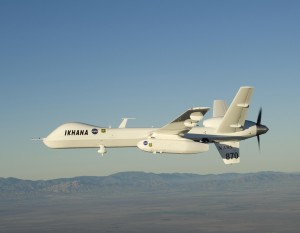
With smoke from the Lake Arrowhead area fires streaming in the background, NASA’s Ikhana heads out on a Southern California wildfire imaging mission. The UAV reduces the risk to human pilots to zero.
Vos wasn’t interested in just theory; he wanted to show that the theory actually worked, so he invented and built the world’s first autonomous unicycle—a unicycle robot.
“It turned out that building a unicycle robot is a very challenging controls problem,” he explained. “It was more challenging than most airplane control problems. It had all the attributes that I needed to address if the system was going to be broadly applicable.”
He built it in the lab at MIT, using it as a demonstration platform.
“I wanted to show that all the theory worked well, although the theory was relatively immature at that point, even at the end of my doctoral work,” he said. “The solution that worked for the unicycle was unique. It dropped out of the mathematical formulation, but I needed to extend that to be more generic and applicable to much broader application opportunities, including airplanes.”
After MIT, Vos continued to develop mathematical models, techniques, patents and software. He also worked with a number of companies as a supporting contractor or consultant, providing autopilot and control system solutions based on his theory. It was a way to build a reputation and a portfolio of successful applications. That became the basis for raising money and setting up Athena.
“The software tools will enable you to design for a full operating envelope of a flight control or an autopilot system, which works whether you’re flying at Mach 1.5 at very high altitude or a low-speed landing,” Vos said.
When put into practical use, the software allows a damaged aircraft—for example, one that’s had an aileron separation—to regain controlled flight without input from the pilot. Athena’s adaptive flight control system detects the damage during flight and adapts to the new configuration for the effects of the lost aileron. It then recovers the baseline vehicle performance and successfully lands in the damaged state with Athena’s inertial navigation system, global positioning system and autonomous landing system.
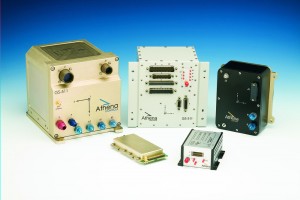
GuideStar models range in size/weight from 0.25 lbs. (small gold box left front) to six lbs. (GS-511 top left) to meet the needs of different aircraft.
“It depends very much on the damage and the specific aircraft,” Vos said. “Some aircraft have a strong dihedral effect, whether it’s actual dihedral or the sweep angle of the wings. The F-18, for example, has good sweep of the wings as well as good control authority across all axes between the ailerons, elevons, flaps, etc.”
He said that even though you use the ailerons to control roll, you can generate a lot of roll authority with a combination of yaw, sideslip and the elevons.
“We know from the equations of motion that the software exploits as much as it can get from the elevons,” he said. “It has a supervisor that’s running all the time, monitoring its performance and adjusting what it’s getting versus what it wants. It then calculates where it can get remaining control authority. If it runs out of elevons, it’ll start using the other surfaces to recover the additional control authority and roll. It runs on top of the autopilot and monitors how well the autopilots are behaving in terms of getting what they expect. It adjusts the autopilot and how it’s getting its control authority so that it actually meets the desired performance.”
GuideStar
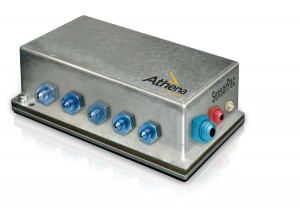
The SensorPac is Athena’s newest product; the company is in the process of FAA certification for use on general and business aircraft.
Vos said that every half-hour an unmanned aerial vehicle takes off somewhere in the world with Athena products on board.
“In very simplistic terms, you plug in an antenna and you plug in power and an interface to the control surface actuators,” he said. “Then you have the ability to push a button and the UAV takes off, flies a complete mission and lands on its own. All the sensors, all the computations, all the flight control laws and all the navigation functions are in a box. You don’t need anything else.”
The box, called GuideStar, includes an INS, a GPS and an air data and attitude heading reference system.
“Numerous non-military applications of the UAV technology exist that are already implemented,” Vos said. “They include weather and climate prediction; border patrol; communication; broadcast; search and rescue; digital mapping; and surveillance for farming, mining and land surveys. More applications are coming. UAVs have the flexibility to adapt to a particular need.”
In 2007, NASA launched Ikhana, a UAV, to monitor the Southern California fires. Vos said the National Oceanic and Atmospheric Administration can snap on another set of sensors and chart ocean currents.

Pilots of U.S. Customs and Border Protection fly UAVs from a control room that may be placed off the airport.
“Today, we can fly cargo to and from remote areas to collection hubs in UAVs,” he said. “But you can also take it to the point of flying cargo in unmanned airplanes, and to the next step, where unmanned airplanes carry passengers.”
Vos believes that when the initial operating costs of the vehicles drop and their liability goes down, general aviation will implement many of these functions.
“In manned aircraft, you have certain capabilities; depending on the airplane or helicopter, it has specific roles,” he said. “The UAVs are similar to manned aircraft in terms of general and specific functions and limitations. The difference is that you can put the UAV into monotonous functions that a crew wouldn’t want to perform or into dangerous environments where you wouldn’t want to risk a crew. Or, you could use a UAV simply because the cost point enables you to do so. In Japan, a lot of unmanned helicopters are used for crop spraying.”
Vos looks ahead to where the market is going.
“Most new airplanes will begin the transition to fly-by-wire technology,” he said. “By definition, those flight control laws are active all the time. Looking down the road, we’ll have those features available for the civilian market. For the UAV market, which is already using fly-by-wire flight control systems with autopilots always active, it’s a very natural next step for them to leverage for civilian functions.”
UAV technology applied to general aviation
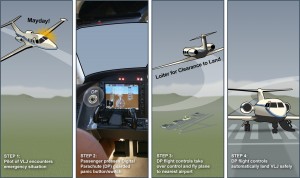
This illustration shows the digital parachute in a VLJ using a combination of Athena technologies and ADS-B to recover controlled flight and land safely, even if the pilot is incapacitated.
Vos said that three elements really open significant doors for the next generation of aviation.
“The digital parachute, ADS-B and the flight control solutions we have today in the UAV systems are applicable for manned aviation,” Vos said.
He said the digital parachute concept would allow the safe recovery of a damaged airplane and the people on board during the flight.
“The assumption is the airplane is still flyable, but the crew or the pilot has become incapacitated for some reason,” he said. “It’s interesting to look at accident rates and how often they occur in the business and GA sector due to situational awareness issues. Say an airplane is in IFR conditions and the crew loses SA, or it’s slipped into bad weather conditions. You’d like to recover automatically, or in the case of a single pilot who becomes incapacitated for some reason, you’d like the folks on board to be able to land the airplane safely. If they’re not pilots, then they need to be able to hit a big panic button so the airplane can recover from whatever condition it’s in to controlled flight. Then it squawks a mayday and is brought in with GuideStar technology, landing at the nearest airport.”
Vos said that looking at the big picture, GuideStar works independently for some of the Next Generation Air Transportation System technology, such as the Automatic Dependent Surveillance-Broadcast, a component of the nation’s future air traffic system that the Federal Aviation Administration wants to employ.
“In our opinion, ADS-B combined with GuideStar is the way to go,” he said. “ADS-B is a highly disbursed tracking system that can use combinations of multilateration or cooperative vehicles to know where each vehicle is, and where they’re going. On the back end of that, you’ll absolutely have automatic routing that’ll direct the vehicles, manage their trajectories, and in areas that are crowded, automatically deconflict them. The direction we’re headed is where the front end can do the ADS-B protocols, and the flight-control systems are reliable enough and cost-effective, so that all airplanes can have them.”
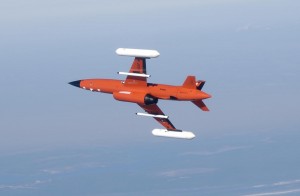
The U.S. Air Force BQM 167A aerial target drone uses Athena Technologies’ integrated sensor suite. The Air Force primarily uses the drone to train fighter pilots.
He said for all airplanes to have those technologies, it needs to be economically feasible.
“We think that’s doable, based on our history of success and what we’re accomplishing today in the UAV business,” he said. “That’ll be a greatly enabling factor in resolving the crowded skies issue.”
Vos said if we fast-forward to where the ADS-B ground and airborne infrastructure is in place, you have the ability to use the digital parachute for recovery and squawk for landing instructions.
“You’ll have the ability to know if any traffic is in the way, to avoid the traffic and for the traffic to automatically reroute itself around any emergency or any trajectory that is being flown,” he said.
This theory removes the human element out of the day-to-day air traffic management system, namely air traffic controllers. For Vos’ theory to work in regards to GA or commercial airliners that transport real people, aircraft having the ability to reroute itself around emergencies will have to address real-life fuel consumption.
Crowded skies and airspace issues
Scores of UAVs are in the skies. Vos predicts hundreds, if not thousands, of very light jets will enter service within the next few years, possibly creating air space management issues.
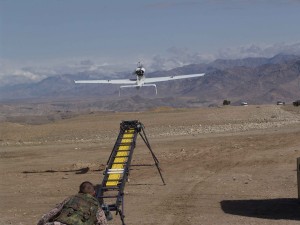
The U.S. Army’s LUNA is an all-weather, lightweight UAV used for real-time surveillance as well as target location at ranges exceeding 50 miles with an endurance of four hours. It uses a GuideStar package that weighs 0.5 lbs.
“I think the FAA is moving in the right direction by creating the ADS-B ground infrastructure,” Vos said. “You can go to any number of websites, find radar feeds of the skies and see what appear to be crowded skies. However, go outside and look up; you’ll find that there aren’t many airplanes overhead at any given time.”
As most commercial airliners fly between 35,000 feet and 39,000 feet, and private, GA business jets fly at 41,000 feet and above, to avoid airline traffic, the naked eye can’t detect aircraft flying overhead. Aircraft flying below reduced vertical separation minimum of 25,000 feet, which are most commonly turboprops and single-engine planes, can be seen.
“When you look at it on a macro-scale, it’s extremely crowded, with lots of dots close together, but when you look at it on a micro-level, where you just look up at the sky, you’ll see airplanes that are well coordinated and routed around each other,” Vos said.
He said you’d have to do a lot of processing in your head, translating those dots on a two-dimensional screen, to see what’s really happening.
“I think it’s a very workable problem; it needs a greater degree of human coordination and automatic coordination,” he calculates. “It’s not as if the airplanes are wingtip-to-wingtip in the air and there’s no more space; it’s just that it’s the right time to develop more generic traffic management and control systems. Of course, we’d all like to see that accelerated.”
Vos says he’s extremely confident that Athena can make it all work.
“We’re flying out of places in the world that are very busy spots,” he said. “Balad Airport (XQC) in Iraq, for instance, is the busiest airport in the world, with manned, unmanned, commercial and military vehicles flying in and out 24 hours a day. It’s all done with carefully managed protocols, and it’s working.”
Stock Flight Systems
Germany’s Stock Flight Systems, an aerospace industry support company, uses Athena’s technology to track its Pitts S2Bs.
“SFS wants to know where they are at all times during their aerobatic routines,” Vos said. “They want to be able to log the data and reproduce it when they land. We can give them a full, three-dimensional trajectory. Velocities, position, altitudes, roll, attitude and headings record 50 times a second onboard that little INS they bought from us. They’re able to display it in the cockpit. Imagine an artificial horizon and a heading display with airspeed and altitude in a multi-function display that a pilot is able to look at, whether he’s inverted, climbing, or pulling high Gs—and he’s getting very accurate information.”
He said if you compare the electronic products that exist today, or more directly compare them to gyro-lock limitations affecting a vertical gyro, you can’t go through full rolls and loops and other aerobatic maneuvers and get accurate information.
“It’s a giant leap forward,” he said.
He said that the pilot still looks out the canopy but only because that’s what he’s accustomed to doing.
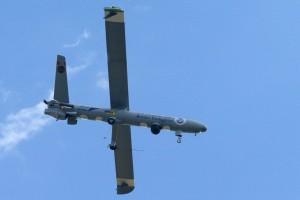
A U.S. Customs and Border Protection UAV patrols the southwestern border. Athena Technologies’ GuideStar helps bring it back safely.
“He could fly the routine ‘under the hood,'” Vos said. “This information can be displayed on a three-dimensional view we call 3-D digital world. The pilot can fly his routine with a bird’s eye view of his airplane by looking at his screen. That’s the way we train many of the unmanned systems operators before they fly the vehicles.”
He said they do a simulation that captures the exact data collected by the company’s onboard devices.
“Data is projected onto a screen so the operators can fly it as though they’re not on board the aircraft,” he said. “The pilot can fly the airplane from a view on board or outside or looking at his instruments. He can also see the scene from above, or a side view looking at himself and the airplane in the air.”
Vos believes this technology can be transferred to business aviation, and when more affordable, to private pilots under the banner of GA.
“As we’re going through the certification process, we’re working to bring the technology down to GA prices,” he said. “It’s going to happen; Athena is driving it. We’re making enormous strides, and it’s very exciting. Ten years ago, folks told us we couldn’t do certain things in the UAV field. We pioneered it, and now we’ve made a huge difference in that field.”
For more information, visit: [http://www.athenati.com].











